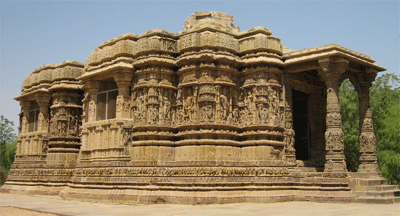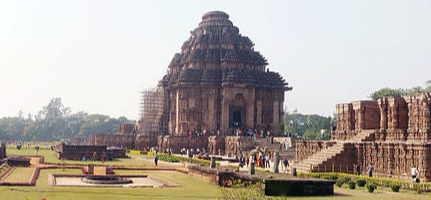The Sun, known as 'Pratyaksha Daivam'
Who is that god whom we can see? Sun is the God whom any one can see. Sun is the source of energy. Surya refers to the Sun in general.Surya is also known as Aditya. From the fact Surya's name is being mentioned in all the Hindu scriptures ,it can be concluded worshiping of Surya is as ancient as the creation itself.
Surya is worshiped in many forms. Out of these forms two forms of Surya worship are mention worthy. One form is 'Arka' form. Surya is worshiped in Arka form, (Arka in Sanskrit means Sun, fire.) in northern India and eastern parts of India. Examples are, Konark in Orissa, Uttararka. Lolarka in the state of Uttar Pradesh.Balarka in Rajasthan,
The other form of surya worship is "Mitra" form. Mitra in Sanskrit means friend or well wisher. Because like a good friend or a well wisher Surya endows the humanity all that is good and for human welfare.In Gujarat, SuryaVanshi kings are known as Mitravanshi Kshatriyas.
References of Sun worship are aplenty. In Ramayana, sage Agastya teaches Aditya Hridaya Mantra to Rama and asks him to worship the Sun.
The great Astronomer Varahamihira references the details pertaining to Surya worship in great detail.
Owing to the hot and dry nature of Surya, Vedic astrology, considers Surya as malefic. Mal;efic meams that which does bad.
Sun, as the principal deity there are many temples in India. An interesting aspect is that , the temples dedicated to Siva will dedicate a small shrine to Surya also. It's not all, several temples in Andhra Pradesh. Tamilnadu etc show that the Sun worshipped the principal deities of those respective temples regularly. Many of those temples are designed such that the Sun's rays fall directly in to the sanctum sanctorum. We come across the instances of naming the sacred tanks of some temples are named as "Surya Pushkarini."
Among all the Sun temples spread over the length and breadth f India,the World Heritage site, Konark temple located in the state of Odisha stands tall. There are two other Sun temples in Odisha's Ganjam and Bhadrak districts both of them bear the same name, "Birinchinarayan Sun temple."
Let me take you on a journey through some famous Sun temples of India.
Dakshinarka temple
Located at Gayam in the state of Bihar, Dakshinarka temple, well known for its antiquity. Offerings to the ancestors are made at the Surya Kunda also known as Dakshina Manas tank in front of the temple. History books say about the popularity of Sun worsgiping during Magadha regime. Though there are many references of Dakshinarka temple in the ancient scriptures and established the temple's antiquity, the present structure of Dakshinarka temple dates back to 13th century. Pratapa Rudra, the last ruler of Kakatiya dynasty, who ruled with Warangal as capital built Dakshinarka temple.
Dakshinarka temple faces east. It stands very close to the famous Vishnupada temple. At Vishmupada temple foot prints of Vishnu are worshiped in a temple. In an otherwise simple temple, the Sabha Mandap in front of the Sanctum attracts people with its massive pillars and the skilfully sculpted sctlptures of Siva,Brahma,Vishnu, Surya and Durga.
Uttararka temple near the Uttara Manas tank and Gayaditya temple on the riverFalgu are to other famous temples at Gaya.
Brahmanya Dev Temple
Located at Unao, near Jhansi. Madhya Pradesh, Brahmanya Dev Temple is a popular tourist spot. A belief among the people, that a visit to this temple will cure chronic skin diseases and blindness. Owing to this, Brahmanya Dev Temple has established it self with the tag, "The Most Visited temple."Standing on the brick platform covered with black plates, the stone image of Surya delights the visitors.
In the temple there are 21 triangles engraved synbolizing, 21 phases of the Sun.
Ravivaar, the Sunday is the day exclusively dedicated to Sun worship. Peshwas were the chief patrons of Brahmanya Dev Temple besides the ruler of a nearby town, Datia.
Surya Pahar Temple
This temple houses 12 images of Surya in a circle on a circular stone platform or tablet. The center of the tablet there adores an image of Kashyapa, the father of Aditya. Kahyapa is also known as Prajapati. Surya is believed to be the son of Aditi and Kashyapa. Each of the image of the Sun is depicted as one faced with two arms. The Sun temple is located in the close proximity of a hill named Surya Pahar, which is located in Goalpara in Assam.According to Kalika Purana, Surya Pahar is the abode of Sun forever. Surya Pahad temple is a treasure of archeological remainings. Besides many rock cut figures of superlative quality, at the foot of the hill there are several Sivalingams made of stone.
Suryanaar temple
Kumbhakonam in Tamilnadu as replete with great temples. Suryanaar temple is located near Kumbhakonam. Suryanaar temple doesn't house Just Sun god only. Besides Sun, there are other deities, Kasi Viswanatha and Visalakshi and eight celestial bodies. Suryanara temple follows a strict protocol in worshiping all the Gods enshrined innthe temple.The last act of the protocol is making rounds or "Pradakshina" around the temple for nine times.
The 800 year old Suryanaar temple is built according to Dravidian culture. This temple was patronised by the Chola kings.Suryanaar temple gas attained more importance with the inclusion of this temple in the list of temples to be visited in the Pacjage tour of "Navagraha Sthala Tour" devised by Tamilnadu Tourism Development Corporation.
Suryanarayana Swamy Temple
Suryanarayana Swamy temple is located in a place called Arasaville in the state of Andhra Pradesh. This temple is believed to be built by a Kalinga king, dates back to 7th century. The 5 feet tall image is made of Black Graniten and depicts Suryanarayana Swamy as holding lotus buds. This sculptural depiction of Surya gave him the name ,"Padma Pani."In this image we can see Surya is flanked by Usha and Chaya.
 The Sun Temple at Modhera.
The Sun Temple at Modhera.
There is a similarity in the designing of the temple with that of Konark Sun temple. In both the temples, the rays of the Sun fall on the image of Surya at the time of equinoxes. Equinoxes are the two days in an year when the Sun passes over the equator. On these two days both daylight and night time are of the same length in all parts of the globe.
One can easily grasp the archetectural grandeur of this grand temple in its hey days even from whatever little is left in the temple after the passage of time. Owing to this reason, even today its the stage for Modhera Dance festival featuring the who is who of grand dance masters of the cointry. The great tank infront of the temple has many exquisite images which make a big dent on the hearts of the viewers.
The Sun Temple at Konark
See the visual of Konark temple at the very outset og this article. This temple of 13th century stands as the testimoney for the temple archetecture especially Sun temples of India. It excels in all respects over the other Sun temples of India.Konark which is located 20 miles north-east of Puri, means corner Sun. Konark temple resembles the chariot of the Sun drawn by seven horses symbolizing the seven days ofthe week. The 24 wheels of the chariot are the masterpieces of sculptural art of highest quality that cannot be seen in any temple in India.
Martand Sun temple
This temple is located near Jammu and Kashmir is in complete ruins. Lalitditya Muktapida, a king of Karkota dynasty built this temple during 725-756 AD.The temple was completely ruined by Sikandar Butshikan in the initial part of 15 th century.The Martand temple is a glittering example for ancient temple architecture prevailed in Kashmir. The government of India has developed Martand temple as a tourist center. It was also given the status of "A site of National importance."
Festivals
There are many festivals connected with the Sun God. Out of all the festivals, Makara Sankranti is regarded as the most widely celebrated Hindu festival linked with Sun God. Makara Sankranti is mostly regarded as a harvest related festival. It is known as Pongal in Tamilnadu.Onthis day Milk or rice is made to overflow. Overflowing symbolises abundance in happiness and prosperity. Chath festival which is related to Sun is unique to Bihar stateSamba dashami is a festival celebrated in the coastal areas of Orissa. Samba was the son of Krishna. According to a legend Samba prayed Surya when he was affected by leprosy and he was cured.
Ratha Saptami is another important festival connected with the Sun God.It is also known as Surya Jayanti. It is believed that Sun God is an incarnation of Lord Vishnu.Lord Vishnu in his form Surya is worshipped on Ratha Saptami day or Surya Jayanti day. An offering that comprises of flowers and fruits is called 'Naivedyam'.
This festival is a very important festival during a festival in Tirupati called , "Okka Roju Brahmotsavam." It means, lord Venkateswara on Ratha Saptami day mounts on Seven vahanas or the divine vehicle. otherwise in regular Brahmotsavams, lord Venkateswara takes seven days to mount on seven divine vehicles.
Sun, the first teacher of Yoga and Vedanta (Philosophy)
The Gayatri Manntra which is held in high esteem by all the Hindus is a Solar Mantra. It was taught to the sage Viswamitra in the 'Rigveda'. Great seers like Yagnavalkya, composer of the Shukla Yajurveda, Sukracharya, the Rishi of Astrology and astronmy learnt their respective sciences from the Sun God.
Samba, Sri Krishna's son, who suffered from leprosy was cured by the Sun.This establishes the fact about Sun's healing powers.
Surya and Yogic activities
Many Kriyas or activities in Yoga are linked with Surya, the Sun god. OM, also known as 'PRANAVAM' is known as Solar Mantra.
One of the most important Yogasana, the twelve- cycled Yogic Kriya is well known as "Surya Namaskaram."
The process of activating the Chakras is known as Surya-Dhyanam or Solar Meditation.
Photos : Wikimedia Commons
